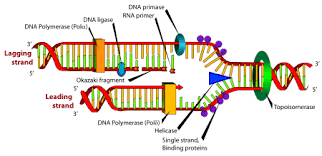

Bits of Mystery DNA, Far From ‘Junk,’ Play Crucial Role
By Gina Kolata
Among the many mysteries of human biology is why complex diseases like diabetes, high blood pressure and psychiatric disorders are so difficult to predict and, often, to
treat. An equally perplexing puzzle is why one individual gets a disease
like cancer or depression, while an identical twin remains perfectly healthy. Now scientists have discovered a vital clue to unraveling these riddles.
The human genome is packed with at least four million gene switches
that reside in bits of DNA that once were dismissed as “junk” but that
turn out to play critical roles in controlling how cells, organs and
other tissues behave. The discovery, considered a major medical and
scientific breakthrough, has enormous implications for human health
because many complex diseases appear to be caused by tiny changes in
hundreds of gene switches.
The findings, which are the fruit of an immense federal project
involving 440 scientists from 32 laboratories around the world, will
have immediate applications for understanding how alterations in the
non-gene parts of DNA contribute to human diseases, which may in turn
lead to new drugs. They can also help explain how the environment can
affect disease risk. In the case of identical twins,
small changes in environmental exposure can slightly alter gene
switches, with the result that one twin gets a disease and the other
does not.
As scientists delved into the “junk” — parts of the DNA that are not
actual genes containing instructions for proteins — they discovered a
complex system that controls genes. At least 80 percent of this DNA is
active and needed. The result of the work is an annotated road map of
much of this DNA, noting what it is doing and how. It includes the
system of switches that, acting like dimmer switches for lights, control
which genes are used in a cell and when they are used, and determine,
for instance, whether a cell becomes a liver cell or a neuron.
“It’s Google Maps,” said Eric Lander, president of the Broad Institute, a
joint research endeavor of Harvard and the Massachusetts Institute of
Technology. In contrast, the project’s predecessor, the Human Genome Project,
which determined the entire sequence of human DNA, “was like getting a
picture of Earth from space,” he said. “It doesn’t tell you where the
roads are, it doesn’t tell you what traffic is like at what time of the
day, it doesn’t tell you where the good restaurants are, or the
hospitals or the cities or the rivers.”
The new result “is a stunning resource,” said Dr. Lander, who was not
involved in the research that produced it but was a leader in the Human
Genome Project. “My head explodes at the amount of data.”
The discoveries were published on Wednesday in six papers in the journal Nature
and in 24 papers in Genome Research and Genome Biology. In addition,
The Journal of Biological Chemistry is publishing six review articles,
and Science is publishing yet another article.
Human DNA is “a lot more active than we expected, and there are a lot
more things happening than we expected,” said Ewan Birney of the
European Molecular Biology Laboratory-European Bioinformatics Institute,
a lead researcher on the project.
In one of the Nature papers, researchers link the gene switches to a range of human diseases — multiple sclerosis, lupus, rheumatoid arthritis, Crohn’s disease, celiac disease
— and even to traits like height. In large studies over the past
decade, scientists found that minor changes in human DNA sequences
increase the risk that a person will get those diseases. But those
changes were in the junk, now often referred to as the dark matter —
they were not changes in genes — and their significance was not clear.
The new analysis reveals that a great many of those changes alter gene
switches and are highly significant.
“Most of the changes that affect disease don’t lie in the genes
themselves; they lie in the switches,” said Michael Snyder, a Stanford
University researcher for the project, called Encode, for Encyclopedia of DNA Elements.
And that, said Dr. Bradley Bernstein, an Encode researcher at
Massachusetts General Hospital, “is a really big deal.” He added, “I
don’t think anyone predicted that would be the case.”
The discoveries also can reveal which genetic changes are important in
cancer, and why. As they began determining the DNA sequences of cancer
cells, researchers realized that most of the thousands of DNA changes in
cancer cells were not in genes; they were in the dark matter. The
challenge is to figure out which of those changes are driving the
cancer’s growth.
“These papers are very significant,” said Dr. Mark A. Rubin, a prostate cancer
genomics researcher at Weill Cornell Medical College. Dr. Rubin, who
was not part of the Encode project, added, “They will definitely have an
impact on our medical research on cancer.”
In prostate cancer, for example, his group found mutations in important
genes that are not readily attacked by drugs. But Encode, by showing
which regions of the dark matter control those genes, gives another way
to attack them: target those controlling switches.
Dr. Rubin, who also used the Google Maps analogy, explained: “Now you
can follow the roads and see the traffic circulation. That’s exactly the
same way we will use these data in cancer research.” Encode provides a
road map with traffic patterns for alternate ways to go after cancer
genes, he said.
Dr. Bernstein said, “This is a resource, like the human genome, that will drive science forward.”
The system, though, is stunningly complex, with many redundancies. Just
the idea of so many switches was almost incomprehensible, Dr. Bernstein
said.
There also is a sort of DNA wiring system that is almost inconceivably intricate.
“It is like opening a wiring closet and seeing a hairball
of wires,” said Mark Gerstein, an Encode researcher from Yale. “We
tried to unravel this hairball and make it interpretable.”
There is another sort of hairball as well: the complex three-dimensional
structure of DNA. Human DNA is such a long strand — about 10 feet of
DNA stuffed into a microscopic nucleus of a cell — that it fits only
because it is tightly wound and coiled around itself. When they looked
at the three-dimensional structure — the hairball — Encode researchers
discovered that small segments of dark-matter DNA are often quite close
to genes they control. In the past, when they analyzed only the uncoiled
length of DNA, those controlling regions appeared to be far from the
genes they affect.
The project began in 2003, as researchers began to appreciate how little
they knew about human DNA. In recent years, some began to find switches
in the 99 percent of human DNA that is not genes, but they could not
fully characterize or explain what a vast majority of it was doing.
The thought before the start of the project, said Thomas Gingeras, an
Encode researcher from Cold Spring Harbor Laboratory, was that only 5 to
10 percent of the DNA in a human being was actually being used.
The big surprise was not only that almost all of the DNA is used but
also that a large proportion of it is gene switches. Before Encode, said
Dr. John Stamatoyannopoulos, a University of Washington scientist who
was part of the project, “if you had said half of the genome and
probably more has instructions for turning genes on and off, I don’t
think people would have believed you.”
By the time the National Human Genome Research Institute, part of the
National Institutes of Health, embarked on Encode, major advances in DNA
sequencing and computational biology had made it conceivable to try to
understand the dark matter of human DNA. Even so, the analysis was
daunting — the researchers generated 15 trillion bytes of raw data.
Analyzing the data required the equivalent of more than 300 years of
computer time.
Just organizing the researchers and coordinating the work was a huge
undertaking. Dr. Gerstein, one of the project’s leaders, has produced a
diagram of the authors with their connections to one another. It looks
nearly as complicated as the wiring diagram for the human DNA switches.
Now that part of the work is done, and the hundreds of authors have
written their papers.
“There is literally a flotilla of papers,” Dr. Gerstein said. But, he
added, more work has yet to be done — there are still parts of the
genome that have not been figured out.
That, though, is for the next stage of Encode.
 If you're seeking job opportunities in a lucrative, rewarding and
exponentially growing field, health care may be your answer. The
CareerCast Jobs Rated report includes numerous health-care sector
careers among its best jobs of 2012, with most ranking in the top 50.
If you're seeking job opportunities in a lucrative, rewarding and
exponentially growing field, health care may be your answer. The
CareerCast Jobs Rated report includes numerous health-care sector
careers among its best jobs of 2012, with most ranking in the top 50.


